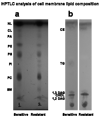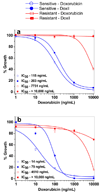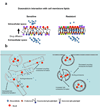Drug resistance in breast cancer cells: biophysical characterization of and doxorubicin interactions with membrane lipids
- PMID: 20958074
- PMCID: PMC2997943
- DOI: 10.1021/mp100308n
Drug resistance in breast cancer cells: biophysical characterization of and doxorubicin interactions with membrane lipids
Abstract
Understanding the role of lipids in drug transport is critical in cancer chemotherapy to overcome drug resistance. In this study, we isolated lipids from doxorubicin-sensitive (MCF-7) and -resistant (MCF-7/ADR) breast cancer cells to characterize the biophysical properties of membrane lipids (particularly lipid packing and membrane fluidity) and to understand the role of the interaction of cell membrane lipids with drug/nanocarrier on drug uptake and efficacy. Resistant cell membrane lipids showed significantly different composition and formed more condensed, less fluid monolayers than did lipids from sensitive cells. Doxorubicin, used as a model anticancer agent, showed a strong hydrophobic interaction with resistant cell membrane lipids but significantly less interaction, as well as a different pattern of interaction (i.e., ionic), with sensitive ones. The threshold intracellular doxorubicin concentration required to produce an antiproliferative effect was similar for both sensitive and resistant cell lines, suggesting that drug transport is a major barrier in determining drug efficacy in resistant cells. In addition to the biophysical characteristics of resistant cell membrane lipids, lipid-doxorubicin interactions appear to decrease intracellular drug transport via diffusion as the drug is trapped in the lipid bilayer. The rigid nature of resistant cell membranes also seems to influence endosomal functions that inhibit drug uptake when a liposomal formulation of doxorubicin is used. In conclusion, biophysical properties of resistant cell membrane lipids significantly influence drug transport, and hence drug efficacy. A better understanding of the mechanisms of cancer drug resistance is vital to developing more effective therapeutic interventions. In this regard, biophysical interaction studies with cell membrane lipids might be helpful to improve drug transport and efficacy through drug discovery and/or drug delivery approaches by overcoming the lipid barrier in resistant cells.
Figures











Similar articles
-
Epigenetic modulation of the biophysical properties of drug-resistant cell lipids to restore drug transport and endocytic functions.Mol Pharm. 2012 Sep 4;9(9):2730-42. doi: 10.1021/mp300281t. Epub 2012 Aug 7. Mol Pharm. 2012. PMID: 22817326 Free PMC article.
-
Sustained Epigenetic Drug Delivery Depletes Cholesterol-Sphingomyelin Rafts from Resistant Breast Cancer Cells, Influencing Biophysical Characteristics of Membrane Lipids.Langmuir. 2015 Oct 27;31(42):11564-73. doi: 10.1021/acs.langmuir.5b02601. Epub 2015 Oct 15. Langmuir. 2015. PMID: 26439800 Free PMC article.
-
Biomechanics and thermodynamics of nanoparticle interactions with plasma and endosomal membrane lipids in cellular uptake and endosomal escape.Langmuir. 2014 Jul 1;30(25):7522-32. doi: 10.1021/la5015219. Epub 2014 Jun 18. Langmuir. 2014. PMID: 24911361 Free PMC article.
-
Biophysics of cell membrane lipids in cancer drug resistance: Implications for drug transport and drug delivery with nanoparticles.Adv Drug Deliv Rev. 2013 Nov;65(13-14):1686-98. doi: 10.1016/j.addr.2013.09.004. Epub 2013 Sep 19. Adv Drug Deliv Rev. 2013. PMID: 24055719 Free PMC article. Review.
-
Lipids as a target for drugs modulating multidrug resistance of cancer cells.Curr Drug Targets. 2003 Jan;4(1):23-30. doi: 10.2174/1389450033347172. Curr Drug Targets. 2003. PMID: 12528987 Review.
Cited by
-
Syntaxin 6: A novel predictive and prognostic biomarker in papillary renal cell carcinoma.Sci Rep. 2019 Feb 28;9(1):3146. doi: 10.1038/s41598-019-39305-z. Sci Rep. 2019. PMID: 30816681 Free PMC article.
-
Insights into Transfer of Supramolecular Doxorubicin/Congo Red Aggregates through Phospholipid Membranes.Molecules. 2024 May 30;29(11):2567. doi: 10.3390/molecules29112567. Molecules. 2024. PMID: 38893446 Free PMC article.
-
Reprogramming of Lipid Metabolism Mediates Crosstalk, Remodeling, and Intervention of Microenvironment Components in Breast Cancer.Int J Biol Sci. 2024 Mar 3;20(5):1884-1904. doi: 10.7150/ijbs.92125. eCollection 2024. Int J Biol Sci. 2024. PMID: 38481820 Free PMC article. Review.
-
Dysregulation of cellular membrane homeostasis as a crucial modulator of cancer risk.FEBS J. 2024 Apr;291(7):1299-1352. doi: 10.1111/febs.16665. Epub 2022 Nov 7. FEBS J. 2024. PMID: 36282100 Free PMC article. Review.
-
Caffeic acid phenethyl ester reverses doxorubicin resistance in breast cancer cells via lipid metabolism regulation at least partly by suppressing the Akt/mTOR/SREBP1 pathway.Kaohsiung J Med Sci. 2023 Jun;39(6):605-615. doi: 10.1002/kjm2.12675. Epub 2023 Mar 24. Kaohsiung J Med Sci. 2023. PMID: 36960852 Free PMC article.
References
-
- Seddon AM, Casey D, Law RV, Gee A, Templer RH, Ces O. Drug interactions with lipid membranes. Chem. Soc. Rev. 2009;38:2509–2519. - PubMed
-
- Hendrich AB, Michalak K. Lipids as a target for drugs modulating multidrug resistance of cancer cells. Curr. Drug Targets. 2003;4:23–30. - PubMed
-
- Pallarés-Trujillo J, López-Soriano FJ, Argilés JM. Lipids: A key role in multidrug resistance? (Review) Int. J. Oncol. 2000;16:783–798. - PubMed
-
- Pajeva I, Todorov DK, Seydel J. Membrane effects of the antitumor drugs doxorubicin and thaliblastine: comparison to multidrug resistance modulators verapamil and trans-flupentixol. Eur. J. Pharm. Sci. 2004;21:243–250. - PubMed
Publication types
MeSH terms
Substances
Grants and funding
LinkOut - more resources
Full Text Sources
Other Literature Sources
Medical
Research Materials

